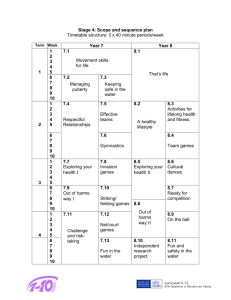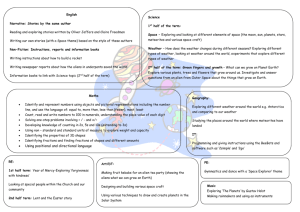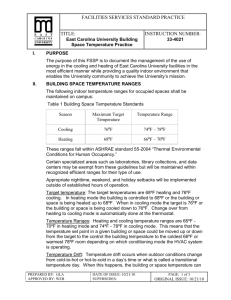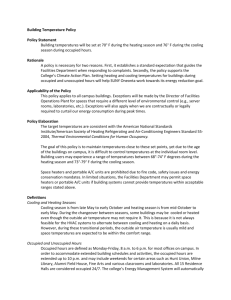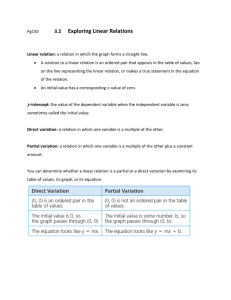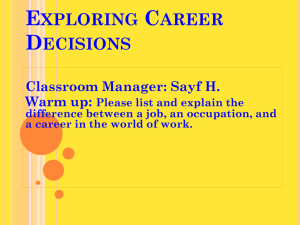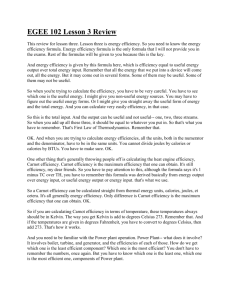Texas A&M University
advertisement
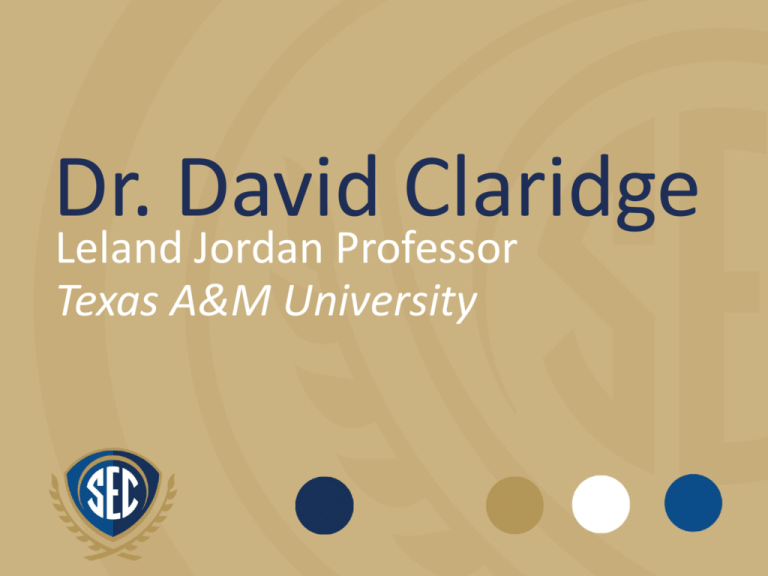
Dr. David Claridge Leland Jordan Professor Texas A&M University Exploring the Limits of Energy Efficiency and Demand Reduction in Office Buildings David E. Claridge and Oleksandr Tanskyi Mechanical Engineering Dept. and Energy Systems Laboratory Texas A&M University 2013 SEC Symposium Atlanta February 10-12, 2013 Imagine Carbon Neutral Buildings Assume all energy from renewable sources, e.g. Photovoltaics Biomass Wind Solar Thermal Photo courtesy of: sine.ni.com Less Energy Used = Less Energy Production Impact More flexibility in building design/construction May lower life cycle cost Talk about 30% and 50% less energy than code The “Carnot Limit” to energy needed defines one boundary of energy use/supply tradeoffs Exploring a “Carnot Limit” for Energy Systems Lab Energy Use 25,774 ft2 Minimally Code Compliant Building Energy Code Program OK’d with Envelope 10 losses 20% above code Rooftop air conditioners w/EER = 10.0 On/off Night operation setback Electric heating BASELINE BUILDING: MEASURED CONSUMPTION 350,000 KWH/YR Other; 313; 0% Ventilation fans; 102,165; 27% Ventilation 27% Cooling Cooling; 103,886; 28% 28% Lighting 21% Area Lights; 80,248; 21% End-use Equipment; 71,332; 19% Plugs 19% Heating 5% Heating; 18,806; 5% Basic Building Requirements Cooling and Heating for Comfort Ventilation for Healthy Air Lighting Computers/Printers Copiers Cooled Drinking Water Heating Hot – Lunch and Coffee Water – Restrooms Building Assumptions Comfort – Maintain 73ºF/50% Relative Humidity Ventilation – Meet ASHRAE Ventilation Standard Lighting –IESNA recommended levels Computers – 1/person Monitors – 2/person Printers – 1/person ESL Building Assumptions Copiers: 1/60 people (2000 pages/person/yr) Cooled Drinking Water: 1 Qt/person/day Heating: (1 Cup water)/person/day Heated from 70ºF to 212ºF Hot Water-Restrooms: ½ gal/person/day Cooled from 70ºF to 50ºF Heated from 70ºF to 105ºF Occupied 60 hours/week Exploring The Limits What are the limits? What is the minimum energy required to meet each of these office building requirements/services? Exploring The Limits: Lighting Chose average of Illuminating Engineering Society of NA recommended 20-50 fc 400 – 700 nM radiation from 5800K black body ~250 On Lumens/Watt 6 hr/day weekdays LED LIGHTS Exploring The Limits: Lighting 35 foot-candles => 0.13 W/ft2 when occupied 0.01 W/ft2 unoccupied 1.7 kW avg. occupied without daylighting 0.85 kW avg. occupied with daylighting 0.24 kW unoccupied Exploring The Limits: Computers No obvious physical limit Assume 2.5W for 1 GHz processor (e.g. iPhone ) Hibernate when not in use Assume 30 hr/wk for 128 people => 147 W average when occupied Exploring The Limits: Monitors Assume limit is lighting power Two 1.5ft2 (23-in) monitors per person 250 candela/m2@250 Lumens/W=> 1.75 W/monitor Sleep when not active 6 hr/day for 256 monitors 206 W average when occupied Exploring The Limits: Printers Physical limit not obvious Ink jet printer is ~0.07 Wh/page 2000 pages per person/year => 7 W average when occupied Exploring The Limits: Copiers 2,000 copies/person per year at Energy Systems Lab Use same energy assumptions as printer 7 W average when occupied Exploring The Limits: Cooled Drinking Water 1 Qt/day per person from 70ºF to 50ºF Use Carnot refrigerator COPCarnot = 28.3 => 4.3 W average for building (when occupied) Exploring The Limits: Heating Food/Water 1 Cup water or equivalent food per person daily from 70ºF to 212ºF Carnot heat pump COPCarnot = 4.66 for 70ºF to 212ºC => 53 W average for building (when occupied) Exploring The Limits: Heating Water - Restrooms ½ gal/person per day 70ºF to 105ºF Carnot heat pump COPCarnot = 15.65 for 70ºF to 105ºF => 31 W average for building (when occupied) Exploring The Limits Cooling and Heating Loads Electricity used in space Occupants Solar Ventilation Heat power gain/loss through walls, etc. Exploring the Limits: Electricity in Space Source Lighting Computers Monitors Printers/Copiers Water Cooling Heating Food Restroom HW Total Occupied (W) 838 147 206 14 4.3 53 31 Unoccupied (W) 240 0 0 0 0 0 0 1,293 W 240 W Occupant Gains ASHRAE: Moderately active office work: 73 W/person sensible 59 W/person latent Assume => 40 hours/week/person 6,250 W sensible 5,000 W latent Exploring the Limits: Solar Gains Theoretical limit is zero We assume the amount of solar gain corresponding to the amount of daylight => 850 W average occupied gain Exploring the Limits: Ventilation Energy ASHRAE Ventilation Standard requires 2,190 cfm outside air when occupied Assume Perfect enthalpy recovery device Exhaust air = outside air intake 0.02 inWG fan pressurization Perfect fan => 5.1 W fan power when occupied is only ventilation energy required Exploring the Limits: Wall/Window/ Roof Gains/Losses Theoretical We limit is zero assume zero Exploring the Limits: Cooling and Heating Assume: “Free” cooling when conditions permit Carnot chiller for cooling otherwise Carnot heat pump for heating Exploring the Limits: Chiller Electricity Assume Houston, TX Weather Total cooling 40,161 kWhth Free cooling meets 24,595 kWhth Chiller provides 15,566 kWhth Chiller requires 250 kWh Average COP = 62 Exploring the Limits: Heating Heating Load is zero Heating electricity is 0 kWh! Today’s Buildings vs. “Carnot Limit” Building U.S. average is 82 kBtu/ft2-yr “Carnot Limit ” is 0.73 kBtu/ft2-yr ESL Building is 50 kBtu/ft2-yra Today’s Buildings vs. “Carnot Limit” Building U.S. average is 82 kBtu/ft2-yr “Carnot Limit ” is 0.73 kBtu/ft2-yr ESL Building is 50 kBtu/ft2-yr “Zero Energy” Bullitt Foundation Cascadia Center is planned for 16 kBtu/ft2-yr a What About Peak Demand? ESL Building 138 kW summer 178 kW winter What About Peak Demand? ESL Building 138 kW summer 178 kW winter “Carnot Limit” Bldg 2.2 kW summer 1.6 kW winter 1-2% of ESL Bldg What Can We Achieve? This IBM 7094 Had a tiny fraction of the capability of the Iphone Incremental” Improvement is important, BUT Incremental” Improvement is important, BUT There is room for SPECTACULAR progress in Energy Efficiency! Pursue Disruptive Change ?? David Claridge dclaridge@tamu.edu Dr. David Claridge Leland Jordan Professor Texas A&M University
